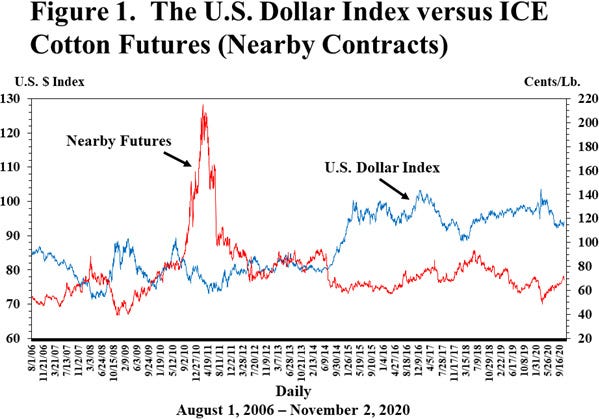
No, I am not predicting dollar cotton.
I am reflecting on the influence of currency markets, and particularly the U.S. dollar, on cotton prices. During 2020, the U.S. dollar weakened a lot during the pandemic recession, and has since leveled out a bit. This is shown by a downtrend in the blue line in Figure 1.
In general, the two data series in Figure 1 have an inverse relationship. That is, when the dollar weakens, reflected by a down trending U.S. dollar index, cotton prices tend to strengthen, and vice versa. Statistics bear out the inverse relationship, as a simple regression of the data series in Figure 1 confirms. However, the real picture is more complicated.

I can think of at least two reasons for cotton prices to move in opposite direction of the dollar. First, there is the speculative influence, variously referred to as “safe haven” or “risk on/off” aspect of currency markets, i.e., flows of investment money into or out of safe investments. Whenever investors turn away from riskier investments like stocks and commodities, such as during the fall of 2020, frequently they park their money in dollar denominated bonds or bank deposits. Such movements may explain some of the patterns in Figure 1, and they have little to do with cotton economics.
The second, more fundamental reason for the dollar’s influence on cotton prices involves export competitiveness. A weakening U.S. dollar in theory would stimulate more U.S. exports of physical cotton since it would be cheaper relative to competing foreign cotton sources.
The U.S. dollar index (DX) graphed in Figure 1 precisely reflects the value of the U.S. dollar relative to combination of the euro, Japanese yen, British pound sterling, Canadian dollar, Swiss franc, and the Swedish krona. Those six countries and currencies have little to do with cotton economics. However, to the extent that U.S. dollar strength (for whatever reason) against these currencies coincides with U.S. dollar strength versus cotton exporting countries (e.g., Brazil, Australia, Central Asia, and sometimes India), then this chart may reflect situations where a strengthening dollar is directly associated with lower U.S. export competitiveness.
Fortunately, the more cotton-specific impact of the U.S. dollar value on U.S. exports can be inferred from USDA calls “trade-weighted exchange rate indices.” These USDA indices suggest, for example, that back in 2015 when the U.S. dollar was up over 10% year-over-year, it was really only 6% more expensive to foreign buyers compared to other cotton exporting countries.
I apologize again for not talking about dollar cotton.
For additional thoughts on these and other cotton marketing topics, please visit my weekly on-line newsletter at http://cottonmarketing.tamu.edu.
About the Author(s)
You May Also Like




